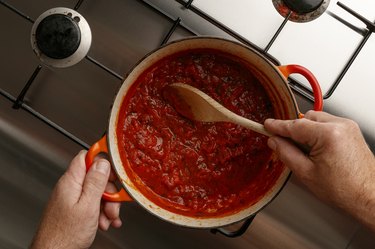How to Get Rid of Burnt Taste in Gravy

Burnt sauces can be saved by various pantry staples.
Image Credit: Phill Thornton/iStock/GettyImages
There are many different ways of removing a burnt taste from sauces, soups and gravies. The strategy you should use depends on what exactly has been burnt.
If you've burnt a soup, you can usually separate the unburnt liquid from the burnt bottom and continue cooking it at a lower temperature. However, if you've burnt steak or a vegetable while cooking it and intended to make a sauce from it, fixing your burnt food can be a bit more complicated.
Fixing Burnt Soup and Sauces
Roasted coffee beans, rotisserie chicken, dark caramel and charred cauliflower chowder or our Spicy Roasted Cauliflower are all foods that taste good because of a chemical reaction known as the Maillard reaction. According to a January 2015 article in the International Journal of Food Science, this is a non-enzymatic browning reaction that occurs when foods have been prepared at high temperatures.
Unfortunately, it can be all too easy to overcook foods and burn them. While burning soup might occur from simple overcooking, the Culinary Institute of America says that burning sauces can occur from both overcooking and over-reducing.
If you've accidentally burnt a soup or sauce, there are several things you can do to rescue your food. If you're in the process of cooking and have discovered that you've burnt a soup, sauce or piece of meat, you should stop cooking immediately and try to move the unburnt food to another pan or container.
Typically, burnt soup, sauces and other liquids will only have burnt on the bottom, where the heat has been applied. At this stage, it's salvageable because you can pour out the unburnt part, leaving the burnt soup or other food stuck to the bottom of the pot. Never scrape the bottom of the pot, or you'll ruin the remaining food.
Tip
This situation is reversed if you're broiling. In this case, you may have burnt steak, carrots or some other food. The item would appear charred on top, rather than burnt on the bottom. Cut off the burnt sections to see what can be salvaged from your food, but be aware that your food may have burnt all the way through.
Next, you'll need to taste the unburnt food. Depending on how much you've burnt, you can try a few different things.
Essentially, you'll need to balance out the flavors in your food. A splash of white wine can be a good addition to a food that is barely burnt. You can continue cooking this at a lower temperature, as if you never burned it at all.
Other common ingredients that can help resolve burnt flavors include lemon juice, tomatoes, onion, sugar, sherry and Madeira wine. However, it can be easy to overdo these flavors too. You may need to add some sort of fat (like half-and-half or coconut cream) to round out your final dish.
Using Burnt Foods and Sauces
Keep in mind that you don't always need to fix a burnt sauce or other food. If you can't fix your burnt soup or sauce, you might not be able to use it for what you wanted to originally. However, burnt soup, meat, vegetables and sauces can often be used in other dishes.
Many dishes actually use burning as their key cooking method. Intentional burning is what makes them unique. These range from certain Mexican moles to "kazandibi," a Turkish milk pudding.
In fact, certain burnt sauces are key components in traditionally made meals. Burnt aioli, for instance, often accompanies dishes like broiled cod or cuttlefish risotto in Spain. Vietnamese "nuoc mau," a burned caramel sauce, is added to meats, rather than desserts, to bring out umami flavors.
Umami, which an October 2013 article in the journal Trends in Food Science & Technology defines as a savory flavor, is due to the presence of certain types of amino acids. It's found in foods like mushrooms, soy sauce and miso soup. It's also commonly found in barbecued and charred foods. Given how familiar these flavors are, you're a lot less likely to be displeased with burnt chicken or ribs.
Umami-rich dishes with burnt components typically have a smoky, charred aroma to them. They might remind you of a campfire, but they rarely taste distinctly burnt.
How to Get Rid of Burnt Taste in Gravy
Source: https://www.livestrong.com/article/476400-how-to-remove-burnt-taste-from-sauces/
0 Response to "How to Get Rid of Burnt Taste in Gravy"
Post a Comment